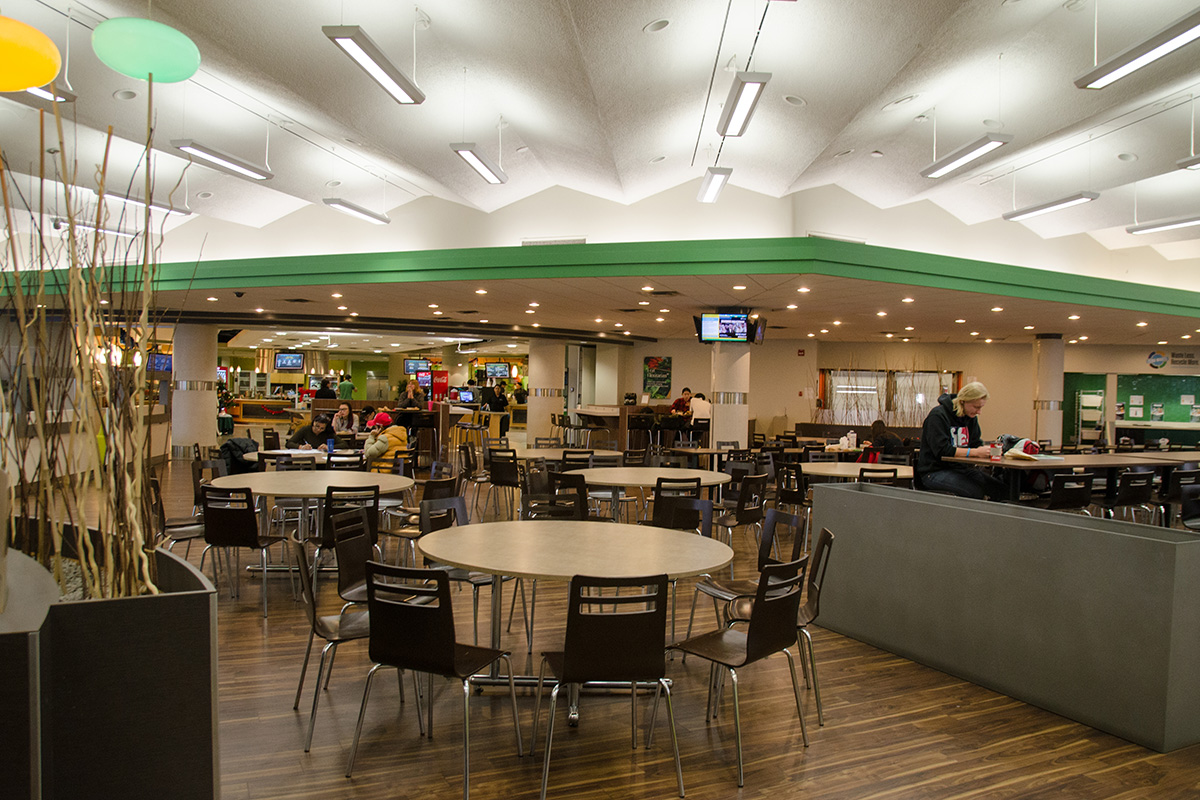University now considering options for Lister meal plan in 2017-18
 Zoe Joyall
Zoe JoyallNow that a $4,550 all-you-can-eat Lister Hall meal plan for 2017-18 was rejected last month, the university is considering multiple options for next year’s Listerites.
A proposal for another 2017-18 meal plan will be brought to a future Board Finance and Property committee meeting — the next of which will be held on February 28, 2017. A meal plan proposal will be drafted so it can be brought to the Board of Governors meeting on March 17 for final approval, according to university spokesperson Alison Turner. The university is now considering a few different options for next year’s Lister meal plan, one of which being the declining balance model currently in use, which functions like a debit card. The price hasn’t yet been decided.
The university’s long-term goal is still to transition Lister to an all-you-can-eat model, said Vice-President (Facilities and Operations) Andrew Sharman.
“The ultimate aim is to have some form of anytime dining in Lister,” he said. “From all our studies and visits that is the best in class and I think all our students who live in residence are entitled to best in class.”
Residents currently pay $3,873 or $4,583 and are able to use that money to buy food in Lister, the Students’ Union Building (SUB), and the Central Academic Building (CAB).
The proposed all-you-can-eat meal plan was about $700 more expensive than the current plan’s lower tier. It also limited students to eating in Lister and the Peter Lougheed Leadership College, with boxed lunches available for pickup on campus. Sharman said he had a number of one-on-one conversations with the SU about developing the proposal.
Read about what students thought of the all-you-can-eat plan: Students think the proposed Lister meal plan “charges more for less flexibility,” survey says
Under-construction residences Peter Lougheed Leadership College and Lister 5 have both been designed for all-you-can-eat plans, Sharman said. Lister 5 won’t have cooking facilities on any of the floors, unlike the other four towers that have communal kitchens with fridges and stoves.
Future possibilities
After the all-you-can-eat meal plan has been in effect for one year, Sharman said renovations might be made to Lister’s conference room to connect it to the cafeteria. He added that Lister’s food station in its current form is “more than big enough” to accommodate the proposed meal plan.

“There’s no point in spending student money until we have an anticipation of what students want,” he said. “But we believe that with the renovations that have been done the cafeteria are ready to go.”
Residents on the all-you-can-eat meal plan would be offered cold lunches in boxes for pickup in CAB to compensate for no longer being able to use their meal plan in SUB and CAB. Sharman said that within a couple years of implementing the all-you-can-eat plan, a central location could be made to offer hot food, potentially in CAB.
“That’s a challenge,” he said. “I could offer a hybrid meal plan that meets everything (residents want) but it would probably be $7,000.”
Current food quality limited by lower revenue from current plan
Because students at the U of A haven’t experienced an all-you-can-eat plan, Sharman said they should be surveyed on their satisfaction with the current declining balance plan. Sharman also said surveys of students at schools with all-you-can-eat plans like Simon Fraser University in British Columbia should be looked at.
“We have offered in the past to send (Lister residents) to places like Simon Fraser but nobody’s taken us up on that,” he said. “We have done surveys at those universities that have switched to an all-you-can-eat model and satisfaction levels are fantastic.”

Sharman added that the quality of food offered by Aramark, the contractor responsible for food in Lister and many vendors in CAB, is affected by the inconsistency of the declining balance model.
“We contract Aramark to operate the Board of Governors’ facility but then we handcuff them,” he said. “We tie their hands behind their back, we say ‘We want you to be available to feed 1,600 students a day but we’re not guaranteeing you one.’”
While students want flexibility in where to use their meal plans, Sharman said that too much flexibility decreases food quality.
“More will be done, clearly there’s still some misconception out there, and yes flexibility’s a difficult one,” he said. “If you’ve given everyone the maximum flexibility and you try to draw it in to improve things it’s always going to be challenging.”





I hope I’m not the only person to find this absurd. This has been up for debate for years, and I’m sure we’ve all heard the usual arguments against the All-You-Can-Eat Meal Plan. The proposed meal plans have always severely limited the affordability and flexibility of food for students, while simultaneously increasing profits for Aramark’s monopoly substantially. It’s an old, tired argument, and yet I’ve never spoken to a single person in favour of the new meal plan.
How can the University claim to advocate for students if it is clearly undercutting them every year, at every stage of the negotiations? (Hint, they don’t).
This is new though: “I could offer a hybrid meal plan that meets everything (residents want) but it would probably be $7,000.” (Andrew Sharman, VP Facilities and Operations).
Are you fucking kidding me Mr. Sharman? Don’t pardon my profanity, it has never been more necessary. Nobody wants a hybrid meal plan, and nobody has a spare $7000 to spend on it, or on COLD pre-packed lunches in CAB. If that’s the best option you can think of, you’re doing a shit job.
You’ve compared our meal plan to SFU’s. Have you taken a look at their meal plans? Here is the link: https://www.dineoncampus.ca/sfu/dining-plans/purchase. For $3,820 ($1910 per term), residents have unlimited (24/7) access to food in their cafeteria. That’s nearly HALF the amount you’d like our residents to pay for your “hybrid” meal plan, and is still cheaper than ANY existing meal plan for Lister students. Further, SFU students are getting substantially more food (read: unlimited) out of this than current Lister students, and at any hour.
Are you so grossly incompetent that you actually believe this is the best UAlberta can do, or do you like the taste of Aramark’s over-salted, unsanitary jizz down your throat so much so, that you’d bankrupt your students for just another taste?
And finally, don’t pity Aramark because they have to deal with the “inconsistency of the declining balance model.” Really? As far as I can tell, this means that Aramark is upset students are spending money elsewhere. After burning through their meal plan money, students (wisely) opt to pay for better, more affordable food, rather than restocking their OneCards to pay for more overpriced, shitty, Aramark food. This is a problem that Aramark could deal with by simply pricing and serving their food according to the needs of students. If UAlberta wants to stay with Aramark, this is entirely a problem that Aramark can and should have to deal with, rather than the University simply giving them a monopoly to appease their (Aramark’s) greed.
Do a better job.